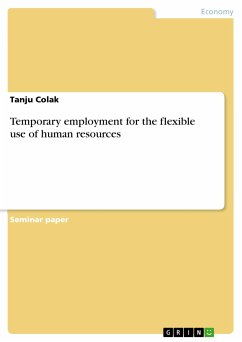Seminar paper from the year 2015 in the subject Business economics - General, grade: 1,3, University of Applied Sciences Braunschweig / Wolfenbüttel; Salzgitter, course: Betriebswirtschaftslehre, language: English, abstract: No other form of employment has gained in importance in such a short period. Since 1990, temporary employment has grown enormously and has gained a larger value than before (Luo, Mann, Holden, 2010). In many companies, temporary work has become an alternative form of employment to cover additional work or personnel shortfalls. Due to this, the social image of temporary employment has increased slightly. Nowadays, companies use temporary employees as an alternative to reduce their cost and remain profitable and competitive in the market (Eisenberg, 1999). This means that many companies use temporary employees to supplement their personnel needs and as a strategy to reduce their personnel cost. Depending on the situation, temporary employment agreements can be both beneficial and harmful to companies (Kirk, Belovics, 2008). On the other hand, temporary work has struggled against quite a negative image. Headlines, such as modern slavery, have been consolidated in connection with temporary work. This assumption highlights that temporary employment is used by companies to reduce labour costs and shift employment risks away from companies to- wards the employees. Therefore, it could be argued why temporary employees offer their manpower at the lowest possible wages without job security or career prospects. A fundamental question that arises here is how temporary employment can be integrated into existing labour and social structures of the company in the event of durable and intensive use and what measures should be considered by companies. According to this, the purpose of this paper is to analyse whether temporary work is a viable alternative to traditional employment. In particular, the advantages of temporary work will be discussed in association with the risks. Looking at the processes of recruitment and the integration of additional decision-making structures, such as the works council, makes it clear that the use of temporary employment requires particular requirements within the internal communication.
Dieser Download kann aus rechtlichen Gründen nur mit Rechnungsadresse in A, B, BG, CY, CZ, D, DK, EW, E, FIN, F, GR, HR, H, IRL, I, LT, L, LR, M, NL, PL, P, R, S, SLO, SK ausgeliefert werden.









